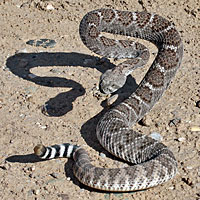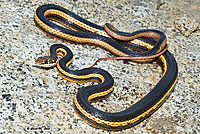 |
| Southern Pacific Rattlesnake |
Reptiles and Amphibians native to Southern California
This page will give you an idea of how diverse SoCal is. There are roughly 33 native snake species are in Southern California, and this blog will go over the most common ones.
Snakes:
The Gopher Snake and the Rattlesnake-How to tell the Difference:
Gopher snakes resemble a rattlesnake; adults can even slap their tail on the ground in imitation of a rattlesnake. Many times people mistake them for dangerous and kill them. But in reality, they are not dangerous at all, have no poison, and will rarely bite. Here are some ways to tell a gopher snake from a rattlesnake:
1. The Rattlesnake is very thick for its size with a rattle on its tail
The Gopher Snake is relatively slender with a tapering tail2. The Rattlesnake has catlike eyes with slits in the middle
The Gopher Snake has round or elliptical black eyes within the colored part
3. The Rattlesnake has a large broad triangle-shaped head
The Gopher Snake's head is slightly wider than the neck
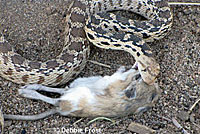 |
| A Gopher Snake from calherps |
The Gopher Snake has a glossy body
5. The Rattlesnake has keeled spiny scales
The Gopher Snake usually has smooth scales
The Gopher Snake:
 |
| A young San Diego Gopher Snake I saw in my backyard |
Description: The Gopher Snake is a large tan or light brown snake with dark brown or black blotches along the back and sides. Adult Gopher snakes commonly grow from 2 to 7 feet long. However they are rather slim for their size with a small head and round eyes.
Habitat: The Gopher snake is found in an abundance of habitats: grassland, desert, coastal sage scrub, riparian, chapparel, and woodlands.
Range: They are found as north as San Louis Obispo to Mexico, and as far east as the western boundary of Joshua Tree National Park
Additional Information: They are fairly commonly seen snakes, especially in spring, when the males are finding a mate, and in the fall, when the babies are starting to become active. They are definitely not endangered; their main threat is humans mistaking them for rattlesnakes. Ratsnakes and kingsnakes are close relatives to them. They are good climbers, sometimes raiding nests, and pretty good swimmers and burrowers. The Gopher snake is active in the daytime, at night in the heat, and espacially at early morning and late day.
The Rattlesnake
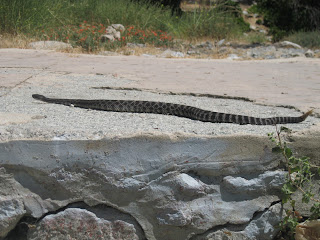 |
| A rattlesnake I saw at Icehouse Canyon, Angeles Nat'l Forest |
This species is almost certainly, the most well-know and feared snake throughout North America. Rattlesnakes belong to a group of poisonous snakes known as pit-vipers. Its habitat ranges far and wide within the United States and other North American Countries. The infamous rattle known across the continent is a remarkable device, made by the Creator, to warn off intruders it is not interested in eating. The most common rattler in the Southland landscape is the Southern Pacific Rattlesnake, but in the desert there are a number of subspecies, which I will not go into detail with, like the Colorado Desert Sidewinder,the Red Diamond Rattlesnake, and, of course, the king of all North American Snakes, the Western Diamond-Back Rattlesnake. It has enough venom to kill 45 men in one fatal bite! There are very few animals that can resist the venom; gray squirrels and badgers are among the few. Please see our Animal Encounters Page on what to do when encountered by a rattlesnake.
Common Kingsnake
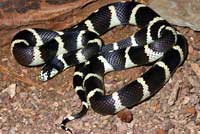 |
| Picture from http://www.californiaherps.com/ |
Description: A small shiny dark banded snake that is usually black or brown. The most common pattern is white or yellow stripes byut there is a wide variety of different patterns. A fairly small snake, kingsnakes rarely exceed 2 or 3 feet in length. they are powerful constrictors and are can kill animals nearly their own size.
Habitat: Grassland, oak woodlands, riparian, coastal sage scrub, semi-arid, marsh and mixed woodland, agricultural riparian, mountain foothills, and conifer forest
Diet: Kingsnakes will eat a lot of stuff including rodents, lizards, amphibians, birds eggs and baby birds, turtle eggs and baby turtles, other snakes. They will eat young rattlesnakes since they can tolerate their poison
Range: The kingsnake's range goes throughmost of the west including in parts of Oregon, Colorado, Nevada, Utah, New Mexico, and Arizona. Most of all though it ranges through all of California except in the very high mountains.
Additional Information:
Turtles:
There are only three turtle species that are common to California: The Western Pond Turtle, the Red-eared slider, and the Western Painted Turtle. They look similar from afar, but the head has different variations. Here are some pictures.
Description: The garter snake is a medium sized snake that can range from all sorts of colors, including brown, yellowish, red and black checkered, gray, and even orange. There is a stripe on the back of garter, or gardener snakes and one stripe on the bottom of the sides. Sometimes the stripe is barely perceptible from the rest of the coloring. They can get long but not that thick.
Habitat: Garter snakes can survive in a variety of habitats from sub alpine (like the juevenile pictured above) to sea level, throughout marshes, forests, woodlands, urbanized areas, chapparel, almost anywhere as long as they can find enough water. They are often found in or around bodies of water such as lakes and rivers.
Diet: Garter snakes will eat pretty much any creature it can catch, including earthworms, slugs, lizards, birds, frogs, rodents, and fish. They swallow their prey whole.
Range: Garter snakes are the second most northern ranging snakes, going as far up as Alaska and Canada down to Central America and occuring all through most of North America.
They are the single most widely distributed reptile in North America.
Additional Information: Garter snakes are diurnal (active in the day time). They are the prey of predators such as raccoons, hawks, crows, and larger snakes. When they feel threatened, they swim into the water if it is nearby. Otherwise they try to run away and hide. As previously mentioned, they are extremely proficient swimmers. In the west they are more aquatic than in the east. Although garter snakes were thought to be non-venomous, recent studies have stated that they in fact have a small venom capacity, however not enough to really harm humans at all. Their young are born live, unlike most snakes, and they can have from 3 to 80 babies in a litter.
California Striped Racer
Description: This nonvenemous small and slender snake is generally 30-60 inches in length when fully grown. Slim and long, with a broad head and large eyes, Striped Racers resembling garter snakes, a main difference is that the racer snake does not particularly like water and swimming, preferring climbing and burrrowing to aquatic activity. The ground color is dark brwon or black and there are stripes on either side of the body that can be white, yellow, or orange.
Habitat: Racer snakes live in a lot of habitats, mainly chaparral, hence the other name, the Chaparral Racer. In addition to that, racer snakes live in grassslands, oak woodlands, and coastal areas. They are absebt from extreme desert areas and anywhere over 7,400'.
Diet: Small mammals, lizards, amphibians, small snakes, and the young eat insects.
Range: Most of California, only absent from the high mountains, desert, and North Coast.
Additional Information: Like most snakes, Racer snakes are diurnal (active in the daytime). For their fairly small size, they are quite viscious and are prone to bite when handled. They are also fast-moving and hard to get close to.
 Perhaps in all of Southern California, there is not one person who has not seen these small, light and swift creatures at one time or another. They vastly populate the Southland's communities, from the busy streets of Los Angeles to the solitary regions of the blistering Mojave. This lizard species thrives in a array of both ruthless and pleasant habitats. They can grow to about 9" long, and weighing only a couple of ounces. Their diet is solely insects, there favorite being ants, but they themselves are the prey of many various other animals, such as snakes, badgers and hawks.
Perhaps in all of Southern California, there is not one person who has not seen these small, light and swift creatures at one time or another. They vastly populate the Southland's communities, from the busy streets of Los Angeles to the solitary regions of the blistering Mojave. This lizard species thrives in a array of both ruthless and pleasant habitats. They can grow to about 9" long, and weighing only a couple of ounces. Their diet is solely insects, there favorite being ants, but they themselves are the prey of many various other animals, such as snakes, badgers and hawks.
Alligator Lizards are large and very fierce lizards fairly common to Southern California. Like most lizards, they can re-generate their tail, which makes up over half of their length, but the new tail will not be as long. Also, some re-generated tails have minor disformities, such as it being forked at the end.
Identification: The largest of all the Southern Alligator lizard sub-species, the SD alligator lizard is 2-7 inches from snout to base of tail, with total length up to 16 inches. The large triangular head, long body and tail, and powerful jaws are what geve to alligator lizard its name. Color is brown, grey, or yellowish on top, with a paler underbelly, and markings on the top of the body.
Diet: Many small bugs and invertabrates, with and occasional small mammal, bird, bird eggs, or other lizard.
Habitat: Open forest, grass, chapparrel. likes to hide under cover of logs, rocks, etc
The Western Fence Lizard
 Perhaps in all of Southern California, there is not one person who has not seen these small, light and swift creatures at one time or another. They vastly populate the Southland's communities, from the busy streets of Los Angeles to the solitary regions of the blistering Mojave. This lizard species thrives in a array of both ruthless and pleasant habitats. They can grow to about 9" long, and weighing only a couple of ounces. Their diet is solely insects, there favorite being ants, but they themselves are the prey of many various other animals, such as snakes, badgers and hawks.
Perhaps in all of Southern California, there is not one person who has not seen these small, light and swift creatures at one time or another. They vastly populate the Southland's communities, from the busy streets of Los Angeles to the solitary regions of the blistering Mojave. This lizard species thrives in a array of both ruthless and pleasant habitats. They can grow to about 9" long, and weighing only a couple of ounces. Their diet is solely insects, there favorite being ants, but they themselves are the prey of many various other animals, such as snakes, badgers and hawks. San Diego Alligator Lizard
Alligator Lizards are large and very fierce lizards fairly common to Southern California. Like most lizards, they can re-generate their tail, which makes up over half of their length, but the new tail will not be as long. Also, some re-generated tails have minor disformities, such as it being forked at the end.
Identification: The largest of all the Southern Alligator lizard sub-species, the SD alligator lizard is 2-7 inches from snout to base of tail, with total length up to 16 inches. The large triangular head, long body and tail, and powerful jaws are what geve to alligator lizard its name. Color is brown, grey, or yellowish on top, with a paler underbelly, and markings on the top of the body.
Diet: Many small bugs and invertabrates, with and occasional small mammal, bird, bird eggs, or other lizard.
Habitat: Open forest, grass, chapparrel. likes to hide under cover of logs, rocks, etc
American Leaf-Toed Gecko
Leaf-Toed Geckos are one of the two only native geckos in North America, though there are several introduced species. The other native species is the banded gecko, not native to California.
Description: Like all geckos, leaf-toed geckos are cute lizards with large eyes and vertical pupils, small scales, and enlarged, padded toes.
Habitat: Around rocks or trees, mainly in desert regions
Diet: Small insects
Additional Information: Most are calm and don't bite if captured, but the tail does break off easily. Geckos lay 1-3 small eggs during he summertime.
Desert Tortoise
 |
| Picture from www.californiaherps.com/turtles |
Desert tortoises are small to medium sized tortoises that inhabit the desert regions of So Cal. They are endangered and protected by law, so never attempt to capture, touch, or molest them. They can be from 8-15 inches long (males are bigger than females) and their color can be yellow, gray, or brown. They are herbivores and feed mainly on grasses, cacti and their fruit/flowers, and desert wildflowers. Along with this plant matter, desert tortoises also ingest rocks and soil, presumably to either help them digest their food or to eat calcium or other minerals found in the rocks.
